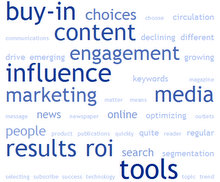Social Media Strategies That Work
 Feeling dazed and confused by the rapidly changing world of social media? Blogs, online multimedia and social networks present tantalizing opportunities for marketers to reach out to their markets in new ways, but the number of options can be dizzying.
Feeling dazed and confused by the rapidly changing world of social media? Blogs, online multimedia and social networks present tantalizing opportunities for marketers to reach out to their markets in new ways, but the number of options can be dizzying.
I help organizations of all sizes understand the tools and tactics of new media. As a 25-year publishing veteran – with the past decade focused exclusively online – I know what it takes to create compelling content that leads to customer affinity and bottom-line results.
My services can cut hundreds of person-hours off your learning curve and get you to market quickly. I’m not an agency or a media buyer. I work with businesses at the front end of their strategy.
I’ll help you address the six key pain points of social media marketing:
- Selling it to the organization
- Choosing tools and tactics
- Creating compelling content
- Search engine visibility and traffic growth
- Identifying and engaging with online influencers
- Measuring results
A Track Record of Authority
 A lot of consultants are hanging out the social media shingle these days, claiming that their general marketing background makes them experts on the new paradigm. While they were busy printing business cards, I was writing two books about the topic.
A lot of consultants are hanging out the social media shingle these days, claiming that their general marketing background makes them experts on the new paradigm. While they were busy printing business cards, I was writing two books about the topic.
My award-winning book, The New Influencers: A Marketer’s Guide to the New Social Media, has been called required reading by scores of media, bloggers and social media experts. My new book, Secrets of Social Media Marketing , is a hands-on manual that educates marketers about how to extend their brands, generate leads and engage customer communities using online tools.
My seminars, speeches and hands-on consulting services can bring those principles home to your company.
Click here to download a PDF of my seminars and training courses.
Click here to download a PDF of my presentations and speaking services.
Contact me to learn how I can get your online social media strategies paying dividends right away.

